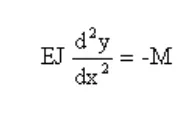Dromoaor
Guest
Hello everyone,
I have a problem with construction techniques and I thought I'd put it in this section of the forum.
I have a pipe diameter 500 mm sp 5mm long 1000 mm steel framed at the ends and subject to force in half-work.
to give more inertia to the section of the pipe, not being able to increase the diameter of the same or the thickness, I was thinking to add it inside the reinforced concrete.
the sectional inertias of the two materials are added because they do not depend on the density, but how do I manage the fact that a material has an elastic module of 210 gpa and another 30 gpa?
I immediately thought about the congruence of the two deformations but I cannot understand how to compose the rigidities of the two materials working in parallel.
I have a problem with construction techniques and I thought I'd put it in this section of the forum.
I have a pipe diameter 500 mm sp 5mm long 1000 mm steel framed at the ends and subject to force in half-work.
to give more inertia to the section of the pipe, not being able to increase the diameter of the same or the thickness, I was thinking to add it inside the reinforced concrete.
the sectional inertias of the two materials are added because they do not depend on the density, but how do I manage the fact that a material has an elastic module of 210 gpa and another 30 gpa?
I immediately thought about the congruence of the two deformations but I cannot understand how to compose the rigidities of the two materials working in parallel.

